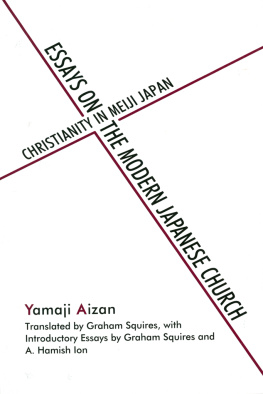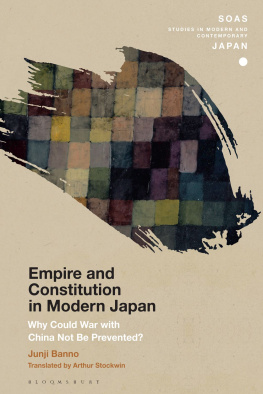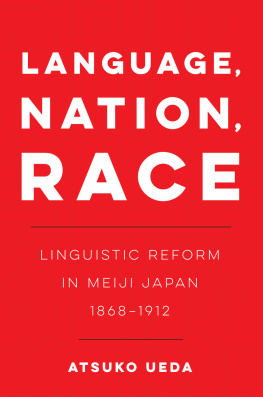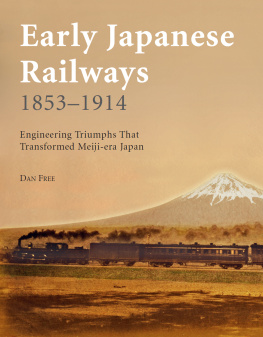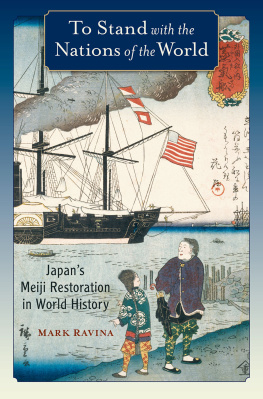Yamaji Aizan - Essays on the Modern Japanese Church: Christianity in Meiji Japan
Here you can read online Yamaji Aizan - Essays on the Modern Japanese Church: Christianity in Meiji Japan full text of the book (entire story) in english for free. Download pdf and epub, get meaning, cover and reviews about this ebook. year: 2020, publisher: University of Michigan Center for Japanese Studies, genre: Religion. Description of the work, (preface) as well as reviews are available. Best literature library LitArk.com created for fans of good reading and offers a wide selection of genres:
Romance novel
Science fiction
Adventure
Detective
Science
History
Home and family
Prose
Art
Politics
Computer
Non-fiction
Religion
Business
Children
Humor
Choose a favorite category and find really read worthwhile books. Enjoy immersion in the world of imagination, feel the emotions of the characters or learn something new for yourself, make an fascinating discovery.
- Book:Essays on the Modern Japanese Church: Christianity in Meiji Japan
- Author:
- Publisher:University of Michigan Center for Japanese Studies
- Genre:
- Year:2020
- Rating:3 / 5
- Favourites:Add to favourites
- Your mark:
- 60
- 1
- 2
- 3
- 4
- 5
Essays on the Modern Japanese Church: Christianity in Meiji Japan: summary, description and annotation
We offer to read an annotation, description, summary or preface (depends on what the author of the book "Essays on the Modern Japanese Church: Christianity in Meiji Japan" wrote himself). If you haven't found the necessary information about the book — write in the comments, we will try to find it.
Yamaji Aizan: author's other books
Who wrote Essays on the Modern Japanese Church: Christianity in Meiji Japan? Find out the surname, the name of the author of the book and a list of all author's works by series.
Essays on the Modern Japanese Church: Christianity in Meiji Japan — read online for free the complete book (whole text) full work
Below is the text of the book, divided by pages. System saving the place of the last page read, allows you to conveniently read the book "Essays on the Modern Japanese Church: Christianity in Meiji Japan" online for free, without having to search again every time where you left off. Put a bookmark, and you can go to the page where you finished reading at any time.
Font size:
Interval:
Bookmark:

ESSAYS ON THE MODERN JAPANESE CHURCH
MICHIGAN MONOGRAPH SERIES IN JAPANESE STUDIES NUMBER 27
CENTER FOR JAPANESE STUDIES
THE UNIVERSITY OF MICHIGAN
ESSAYS ON THE MODERN JAPANESE CHURCH: CHRISTIANITY IN MEIJI JAPAN
YAMAJI AIZAN
TRANSLATED BY GRAHAM SQUIRES,
WITH INTRODUCTORY ESSAYS BY GRAHAM SQUIRES
AND A. HAMISH ION
ANN ARBOR, 1999
CENTER FOR JAPANESE STUDIES
THE UNIVERSITY OF MICHIGAN
Open access edition funded by the National Endowment for the Humanities/Andrew W. Mellon Foundation Humanities Open Book Program.
Copyright 1999 The Regents of the University of Michigan
Published by the Center for Japanese Studies, The University of Michigan 202 S Thayer St., Ann Arbor, MI 481041608
Library of Congress Cataloging-in-Publication Data
Yamaji, Aizan, 18651917
[Gendai Nihon kykai shiron. English]
Essays on the modern Japanese church : Christianity in Meiji Japan / Yamaji Aizan ; translated by Graham Squires ; with introductory essays by Graham Squires and A. Hamish Ion.
p. cm.(Michigan monograph series in Japanese studies ; 27)
Includes bibliographical references and index.
ISBN 0-939512-93-9 (alk. paper)
1. JapanChurch history19th century. 2. JapanReligion18681912. I. Squires, Graham, 1955 . II. Ion, A. Hamish. III. Title. IV. Series.
BR1307.Y3613 1999
275.208dc21
99047907
This book was set in Caslon 540.
Jacket design by Seiko Semones
This publication meets the ANSI/NISO Standards for Permanence of Paper for Publications and Documents in Libraries and Archives (Z39.481992).
Printed in the United States of America
ISBN 978-0-939512-93-5 (hardcover)
ISBN 978-0-472-03829-9 (paper)
ISBN 978-0-472-12795-5 (ebook)
ISBN 978-0-472-90191-3 (open access)
The text of this book is licensed under a Creative Commons Attribution-NonCommercial-NoDerivatives 4.0 International License: https://creativecommons.org/licenses/by-nc-nd/4.0/
CONTENTS
Graham Squires
A. Hamish Ion
Yamaji Aizans Essays on the History of the Modern Japanese Church was first published in 1906. It is significant for two reasons. First, Yamaji was one of the most influential historians of the mid-Meiji period, and it is one of his most important works. This is reflected in the fact that, of all his books and essays, it is the one which has been most often reprinted in Japanese. Second, it was the first history of the Protestant Church in Meiji Japan, and as such it has done much to set the tone for subsequent studies of this subject. The objective of this translation is to make this work available to a wider audience and thereby to enhance understanding of both Yamajis life and thought and the history of Meiji Christianity.
In order to render a historical work from one language into another, it is insufficient merely to translate the text word by word, sentence by sentence, page by page. The audience for which the original text was written and the audience for which the translation is written are clearly quite different. For a historical text to have meaning for a modern audience it is necessary for that text to be located within an appropriate context. In the case of Essays, it can be located within two distinct contextsone is the life and thought of Yamaji Aizan and the other is the historiography of Meiji Christianity. The objective of the first introductory essay is to give an overview of Yamaji Aizans life and thought and to relate this to some of the key elements in his Essays. In the second introductory essay, Professor A. Hamish Ion of the Royal Military College of Canada, Ontario, Canada, examines Yamajis position within Meiji Christianity and locates Essays within the historiography of Meiji Protestantism.
I would like to acknowledge the assistance of Dr. Yushi Ito, Victoria University of Wellington, New Zealand, for the help he so kindly provided as supervisor during my doctoral candidacy; Professor Fred G. Notehelfer, University of California, Los Angeles, for reading and commenting on earlier drafts of the manuscript; and the staff at the Center for Japanese Studies, University of Michigan, for the effort they made in preparing the final version of this book. Finally, I would like to thank my parents, Peggy and Russell Squires, for their support and encouragement over many years.
Graham Squires
June 1999
Graham Squires
Yamaji YakichiAizan was a pen name adopted when he was around twenty years oldwas born in 1864 in the mansion of the Astronomical Institute of the Tokugawa shogunate located in Edo.started to attend a local English school part-time, where he studied the work of John Stuart Mill and Herbert Spencer. In 1884, with a group of friends, he began to study English conversation at the local Methodist Church, and in 1885 the entire group converted to Christianity. Yamaji himself was baptized in March 1886.
In February 1887, Yamaji read, and was greatly impressed by, the first edition of the Kokumin no tomo. As is well known, this journal was published by the Minysha, a publishing company established by Tokutomi Soh. In 1889 Yamaji moved to Tokyo to study at the school of the Methodist Church, the Ty Eiwa Gakk, and while in Tokyo he had the opportunity to visit the office of the Minysha and meet Tokutomi. In July 1890 Yamaji moved to Fukuroi in Shizuoka to work as an assistant pastor. While there, at the recommendation of Tokutomi, he began to read the work of Thomas Carlyle and Ralph Waldo Emerson. It was also at this time that he began contributing articles to journals such as Iwamoto Yoshiharus journal, Jogaku zasshi (Journal of Womens Study). While in Fukuroi, Yamajis writing came to the attention of leaders of the church, and in July 1891 he returned to Tokyo to become editor of the Methodist journal Goky (Defender of the Faith).
In August 1891 Tokutomi invited Yamaji to become a writer for the Minysha. This appointment established Yamaji as a writer of national significance at a time when journalism was developing as a cultural phenomenon of great importance. Following the Meiji Restoration and the introduction to Japan of printing technology using movable type, there was a boom in the publishing industry. Initially newspapers and journals tended to be of one of two types. On the one hand, there were popular newspapers that were rather salacious and that aimed at making a profit. On the other hand, there were elitist papers that focused on politics and were not so much concerned with making money. As the establishment of a constitutional system approached in the late 1880s, there appeared a new kind of publication that sought to deal with important issues but that also attempted to establish a wide circulation. The publishing activity of the Minysha can be seen as being representative of this trend. The Kokumin no tomo was not only con
In January 1893 Yamaji published a short biography of Rai Sany in Kokumin no tomo entitled Sany o ronzu (On Rai Sany). This essay sparked a debate with Kitamura Tkoku who had just established a new literary magazine entitled Bungakukai (Literary World) with Shimazaki Toson and others. The theme of this debate was encapsulated in the title of one of Kitamuras essays, Jinsei ni aiwataru to wa nan no ii zo (What Does it Means to Benefit the World?). It is in connection with this debate that Yamajis name is principally remembered today.
After six years, in 1897, Yamaji left the Minysha, and after working for a short time in the archives of the Mori family, he joined the staff of the Shinano mainichi shinbun (The Shinano Daily News) based in Nagano Prefecture. While in Nagano, Yamaji continued to contribute to national journals, and the content of his writing reflects his increasing concern about social inequality within Japan and about the increasing foreign threat to Japan caused by Western imperialism. In January 1903 he began publishing his own journal,
Font size:
Interval:
Bookmark:
Similar books «Essays on the Modern Japanese Church: Christianity in Meiji Japan»
Look at similar books to Essays on the Modern Japanese Church: Christianity in Meiji Japan. We have selected literature similar in name and meaning in the hope of providing readers with more options to find new, interesting, not yet read works.
Discussion, reviews of the book Essays on the Modern Japanese Church: Christianity in Meiji Japan and just readers' own opinions. Leave your comments, write what you think about the work, its meaning or the main characters. Specify what exactly you liked and what you didn't like, and why you think so.

